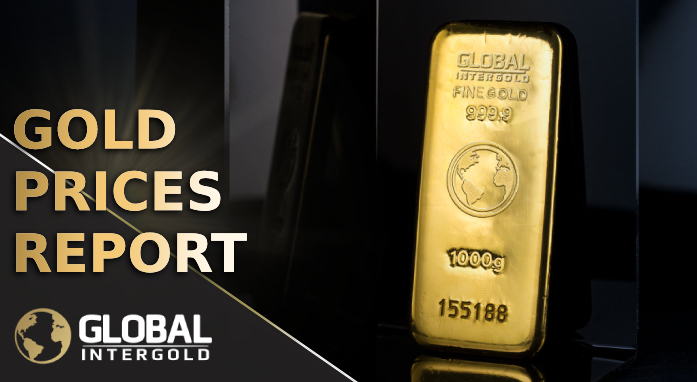Gold prices report on October 22, 2018

Financial experts get ready for the next global crisis, the frequency of which resembles the change of seasons. Bloomberg predicts defaults on the emerging markets. Positions of the UK and Italy are a source of major concern for European politicians; member states of the EU depend on their decisions.
On Monday, October 15, gold kept up an upward trend.
RBC Capital Markets commodity strategist Christopher Louney justifies the increase in the price of the yellow metal. The growing interest in safe haven assets works in favor of gold. Louney claims that yet another spike is expected by the end of the year, the price of gold might reach $1,338.
Experts have noted the recovery of gold that regained strong positions.
On Monday, an ounce of gold cost $1,227.
The Congressional Budget Office announced a six-year record deficit exceeding the budget. Expenditures incurred by the ministries have increased significantly; the costs have exceeded all previously planned marks. Experts warn the government about the consequences of useless spending that will lead to an unacceptable increase of the country’s national debt.
Lukman Otunuga, research analyst for FXTM:
"As trade tension increases, fears of a global growth slowdown and geopolitical tension persist, all the odds are in gold’s favor."
On Tuesday, October 16, the cost of an ounce of gold was $1,225.
On Wednesday, October 17, the US President Donald Trump once again expressed his discontentment with the policy of the Federal Reserve System, calling the Fed "the main threat." According to the head of state, the Fed is "way too independent" with the rate change.
On Wednesday, the cost of an ounce of gold was $1,222.
On Thursday, October 18, experts' forecasts regarding the Fed’s rate hike proved to be true. At the September meeting, the leaders of the Federal Reserve System noted a strong economic growth, guarantying a further gradual increase in the financial regulator’s interest rate. This fact had an impact on the current market sentiment.
Strengthening of the dollar’s position will contribute to additional pressure on the price of gold in the coming weeks.

Analyst and chief economist of Capital Economics Paul Ashworth predicts a rate increase to 3% by the end of 2021.
On Thursday, an ounce of gold cost $1,226.
Countries that increase their gold reserves also strengthen financial security and establish trust in the national economy. This week, Hungary has set a world record, increasing gold reserves tenfold. The Magyar Nemzeti Bank has purchased gold worth $1.25 billion.
On Friday, October 19, Il Messaggero reported on the European Commission's negative reaction regarding the draft budget of Italy. Criticism of the EU stemmed from the huge state debt, the budget increase is out of question under such circumstances. However, Italians believe that such an option can benefit the country's economy. A deadline has been set for the Italian government. The state must respond to the proposed EU recommendations no later than October 22. Former President of the Eurogroup Jeroen Dijsselbloem views the conflict to be the start of long negotiations that could end up as a full-blown Italian crisis.
On Friday, the precious metal continued to grow, the cost of an ounce of gold was $1,226.
On Monday, October 22, an ounce of gold cost $1,228.

A.G. Bisset Associates LLC Chief Executive Officer Ulf Lindahl has predicted a dollar collapse by 2024, following a 40% price fall. Analysts interviewed by Bloomberg calculated that euro will be worth $1.28 by 2022.
Gerald Celente, publisher of The Trends Journal, talked about the signs of worldwide destabilization and the forthcoming growth of gold. In his opinion, gold must break above the $1,450 per ounce, reaching the $2,000 mark afterward.
A trade war, the Fed's rampage and the recent tension between the United States and Saudi Arabia are factors that may affect the zest for gold. Experts are confident that it is almost impossible to reduce gold prices.

![[VIDEO] Young investors choose gold
[VIDEO] Young investors choose gold](https://f01.gig-os.com/74/2c/cc/2b/74/742ccc2b74d465054d6aed797b9de6a1_5.jpg?1)
![[VIDEO] The US legalizes payments in gold [VIDEO] The US legalizes payments in gold](https://f01.gig-os.com/cf/b1/ba/70/55/cfb1ba7055dd2524218f5aabd01efea8_5.webp?1)
![[VIDEO] Record gold demand: market situation in Q1 2025
[VIDEO] Record gold demand: market situation in Q1 2025](https://f01.gig-os.com/0d/85/47/0b/15/0d85470b15a79bc2aabf122c0d401060_5.webp?1)
![[VIDEO] Investors in Asia are buying up gold!
[VIDEO] Investors in Asia are buying up gold!](https://f01.gig-os.com/45/45/84/6f/73/4545846f738945417567ffd2f6f163bb_5.webp?1)
![[VIDEO] Gold price has increased 9 times since the early 2000s!
[VIDEO] Gold price has increased 9 times since the early 2000s!](https://f01.gig-os.com/47/af/07/eb/bb/47af07ebbb01542f14c0aae36a81f1c0_5.webp?1)
![[VIDEO] The US is urgently increasing gold mining — what’s going on? [VIDEO] The US is urgently increasing gold mining — what’s going on?](https://f01.gig-os.com/43/06/89/4d/da/4306894dda97c98b6e595409af58b694_5.webp?1)
![[VIDEO] China sets trends in the global gold market
[VIDEO] China sets trends in the global gold market](https://f01.gig-os.com/5b/81/78/92/92/5b81789292d5e49f20ca7ca093a27cbe_5.jpg?1)
![[VIDEO] Central banks acquired a quarter of the world's gold!
[VIDEO] Central banks acquired a quarter of the world's gold!](https://f01.gig-os.com/81/2d/76/ff/b0/812d76ffb00ee75856059a67a872642c_5.webp?1)
![[VIDEO] Gold: new records amid market volatility
[VIDEO] Gold: new records amid market volatility](https://f01.gig-os.com/03/8b/98/61/b7/038b9861b74be1ae5d57e56e2d2dc859_5.webp?1)
![[VIDEO] Depreciation of money: how to preserve capital? [VIDEO] Depreciation of money: how to preserve capital?](https://f01.gig-os.com/f9/05/87/f3/5d/f90587f35d2d7a1df8880c220372ab8b_5.webp?1)